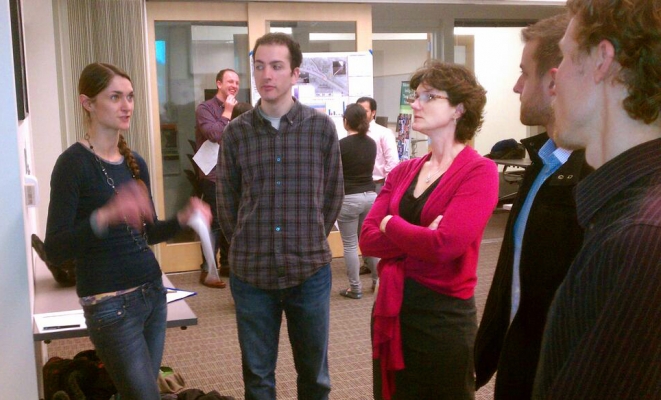Student engineers plan for a safer Beaverton-Hillsdale Highway

The Beaverton-Hillsdale Highway, pegged as one of Portland’s high-crash corridors, already attracted the attention of city officials worried about safety. They got more help from Portland State University students during the recently completed term.
Students from civil engineering professor Christopher Monsere’s transportation safety analysis course formed six groups, each studying a piece of the corridor. They presented their findings and recommendations during the course’s open house March 19. The presentation drew officials from local agencies interested in improving corridor safety, including the city of Portland, the TriMet transit agency and the Metro regional government.
The student work dovetails with the city’s own examination of the highway corridor, completed in February. In some cases, as with the Shattuck Road intersection, the students came to many of the same conclusions as city officials, said Wendy Cawley, traffic safety engineer with the Portland Bureau of Transportation. Both found that narrowing the crossing distance could make that intersection safer for pedestrians.
One group looked at the Hillsdale area, recommending a “road diet” approach and other livability-minded changes. While it’s “probably a little more than the city will be able to recommend and handle,” Cawley said, the work has inspired neighborhood groups that could help build support for the project in the future. Another group found that drivers, their view blocked by a restaurant, creep into the highway’s intersection with Southwest 45th Avenue. The group suggested realigning the roadway away from the restaurant and with another avenue.
“I was impressed they thought big like that,” Cawley said. “They thought of the property owners’ needs and had the whole package.”
A project that caught the attention of both the city and TriMet involved the flashing crosswalk signs called rectangular rapid-flash beacons. The two agencies work together to install the beacons near busy bus stops. Because the beacons at Southwest 62nd Avenue and Beaverton-Hillsdale Highway just went in a few months ago, Cawley said, the students were the first to analyze how well they’re working. They also examined an ODOT installation of beacons at Southwest Barbur Boulevard and 12th Avenue.
Drivers yielded to pedestrians at the beacons between 90 and 100 percent of the time, the students found, compared to other jurisdictions that have a yielding rate of around 88 percent. Students also looked at the rate by lane, finding that the curb lane had a lower yielding rate than the inside lane. “That’s surprising,” Cawley said. “It’s normally the opposite.”
What most struck Cawley was how well Monsere’s students incorporated elements outside of strict traffic engineering. “They thought about livability, about education and enforcement, how businesses might react and how media might react,” she said. “I was impressed by the comprehensiveness of it, because that’s the real world. I’m an engineer but I have to consider all those things.”
